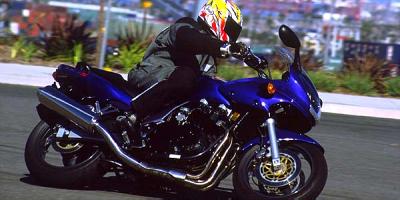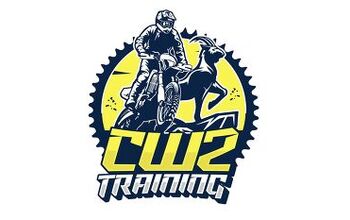2002 Kawasaki ZR-7S - Motorcycle.com
Torrance, California, April 18, 2002 -- After riding the open class bikes, getting on the ZR-7S is somewhat, how you say, disappointing. Not that it's a bad bike, not by any stretch of the imagination. In fact, I'd have to say its one of the better thought-out machines that I've had the pleasure of riding. It's got a center stand, comfortable ergonomics, great mileage, hazard lights and, of course, luggage hooks.
What's up with luggage hooks you ask? Motorcycles are meant to be ridden we say. If that's so, inevitably or invariably, you'll have to use your two-wheeler for something more functional than as a gasoline-to-hydrocarbon converter
The ZR has a large, 5.8-gallon metal tank. In fact, this is one of the few bikes that I've been able to go farther than 200 miles without having to switch to reserve.
Oh yeah, it's got a petcock too. I remember those things. The ZR has an analog fuel gauge as well. It's not terribly accurate, as the needle starts moving after going 25 miles or so. Then at the 160ish mark, the needle is pegged at empty. At the most, I was able to ride until 211 miles showed on the trip 'til I had to rotate the little chrome lever. Then I filled it right to the bottom of the neck. I looked over and sure enough, 5.1 gallons of 87-octane fuel had been added. That equates to about 41.4 miles per gallon.
All that fuel has to go somewhere, and in the case of the ZR, it goes into a 738cc air-cooled inline four. We would be lying if we said that the other manufacturers were scrambling to figure out how Kawasaki made such a mill. In fact, suffice it to say, the powerplant of this 523 pound (measured, wet) motorcycle is downright low tech. A dual-overhead-cam design usually leads to four-valves per cylinder. But in the ZR-7s case, it leads to two.
"Two great big valves will generally contribute to better low-end torque than a similar bore with four itty-bitty valves."
However, in its defense, two great big valves will generally contribute to better low-end torque than a similar bore with four itty-bitty valves. Something to do with high charge volume and relatively low port velocity. Either way, it has eight valves for the whole kit, and combined with a relatively low compression ratio of 9.5:1, it pulls pretty darned nicely from anywhere in the rev-range.
That is, except for below 3,000 rpm, where glitchy seems to be the modus operandi, assuming, of course, the motor is well warmed up. Typical on-choke warm-up time is in the range of a few minutes.
Cruising along at the requisite legal speed limit in top gear--fifth on this bike--the engine lops along at 4000 rpm, which actually is a bit buzzy considering the rest of the cruising rev range is so smooth. Increasing speeds to around 75-80 miles per hour (not recommended; for closed-course use only; for off-road use only; illegal, etc.) revealed a much smoother ride. This allowed me to focus on better, pleasant things. The suspension for example. Granted, this ain't no Ohlins five-figure job, but it gets the job done for freeway commuting, no sweat.
Most of these standard type bikes come equipped with great street/freeway suspension, combined with a supportive seat, and you get a combo that'll keep your body feeling good long enough to take advantage of the ZR's range. But, just like the rest of these standard type bikes, get it cranked over and you'll find the springs are too soft and the dampening is just too slow to respond.
Common practice dictates that stiffer springs and thicker fork oil will fix the soft fork, while perhaps a new rear shock is in order.
However, a quick look through some internet sites reveals that no such thing exists on the aftermarket (except for the oil that is). What to do? Perhaps some spacers in the fork tubes till somebody can mass produce some springs.
While the rear shock is adjustable for preload and rebound damping, the front forks are not.
And while most of the riders will find the stock suspension adequate most of the time, it's those rare occasions that seem to fill the memory banks.
For example, "this bike has great power while cruising at 60mph," versus "thanks to the great power of this bike, I was able to get out of the way of a large truck." See what I mean? The suspension is no different. Along that vein, the brakes raised nary a blip on the radar. I complained to the others in the office that they lacked initial bite, to which they retorted, "you're still here aren't you?" Granted, they are correct in surmising that the brakes are adequate. However, my opinion that they lack initial bite still stands. Other points of contention? Not many, as the ZR-7S follows such a conservative design philosophy that not much is implemented on this machine that hasn't been successful already.
"Here you have a solid frame, decent suspension, and a virtually indestructible (on paper at least) motor."
Combine that with well-thought out touches like mirrors that work, a wind-screen that keeps the wind-blast off and little dongles for 12V accessory plug, and you have the makings of a solid bike. What would I like to see changed?
Well, it would be nice to have fully adjustable suspension bits all around, but as we all know, that costs money, and lots of it--which goes against the suggested price of $5,999 (seems like people are buying these things for a little over 5K).
More changes could be made to the dual, helmet lock and seat lock. They couldn't combine these two locks into one? They're about 6 inches apart for crying out loud. At least they work according to specifications. And for a primarily street bike, there is no clock. Sure you could go to the local auto parts store and pick up a mini digital clock for all of 2 bucks, couldn't they incorporate one into the design of the dash? So who benefits the most from a bike like this? Well for one thing, the Kawasaki's own EX500 and EX250 are also great bikes, but for some of our taller friends, they are just too dang small. Also, while their motors are higher tech in design, the ZR's displacement advantage still makes it a faster machine. A second bike perhaps? All you've got is a monoposto, race-rep? The dual-seater banana seat on this Kawasaki is comfy and features convenient hand-rails. You can also bolt on some bags and ride real far thanks to the pre-drilled rack attachment points. Overall, I gotta say its a solid bike for a solid price. Maybe thats what the "S" actually stands for--Solid with a capital "S."
Second Opinions: JohnnyB
Truly I never know whether to envy or pity the Calvins of the world. When I was his age, I was trying desperately to raise the price of a GPz550--wich was, I think, $2249--but proved to be an insurmountable chunk at the time. I wound up instead with various pre-owned, clapped-out rolling compost heaps from the swingin' '70s.
The sad part is that this new ZR7, I'm quite certain, would run rings around the old GPz, and here the poor thing is, being pooh-poohed and generally looked down the noses upon by MO's poor little rich girls Mini and Calvin--youngsters who've been riding nothing but R1s and CBR954s and Aprilia Mille Rs of late. All I can tell you is that when I swapped a ZX-12 for the little ZR at Kawasaki HQ a couple weeks ago, I wasn't even close to broken-hearted, and though the ZR takes a bit longer to get there, I quickly settled into my usual 80-90 mph freeway cruise. The ZR works a little harder, but seems every bit as enthusiastic, and it is in fact quite a ways more comfortable than the big ZX (whose suspension has to be able to cope with 160 horsepower and 180 mph). In contrast, the little ZR offers a cushier seat, cushier (though well-controlled) suspension, a price tag roughly half of the ZX's--and the option of hard saddlebags even. Right, sure I'd rather have the ZX too, but if money's tight, the ZR ain't so bad, kids. And if in fact a cheap commuter is all you're after, look no further. (The Suzuki SV650 is more hunched-over sporty.)
While I'm on the rant, I've ridden one of these things in the mountains 'til the centerstand and footpegs were but smoldering nubs of molten metal, and nothing gives much more pleasure than hanging onto a pack of thoroughbreds when you're riding the stable pony. With its wide-ish handlebar and upright ergoes, it's not difficult to keep the little eight-valver boiling. Add stickier tires when the stockers wear out, if they wear out, and the ZR will no doubt carve corners like a very unexpected thing. Say, I ever tell you kids about what it was like when we only had three channels on the TV, and you had to walk across the room to surf them? You seen my episiotomy scar Calvin?
Minime
Solid my ass. The "S" stands for Super-fly! Yep, this bike is just craaaazy, baby. Well, maybe not, but is sure is a whole lot better than I anticipated. This may be my favorite Kawasaki ever. It's actually faster than some other bikes in its class and handles pretty well. I didn't even mind riding this beginner's-bike-for-big-people bike. Go figure! And when it wallows through a turn, it has an excuse at the ready: "It's not a sportbike, you idiota!" You can't pull out that trump card for a lot of other bikes we flog here. A lot of which let us down more than this Kawaski ever will. Anyway, it's not terribly ugly, the purple shade not terribly offensive, the brakes not terribly mushy, the motor not terribly buzzy, etc. So that's good. Maybe the "S" stands for "suitable" as in fit for everyday use. Not that I'd use it every day, though. I do like riding it from time to time, however. It makes the rest of my life seem exciting. Then again, it may be just the ticket to spice up yours.
Specifications
ENGINE
Type: 738cc air-cooled, 8-valve DOHC inline fourBore x stroke: 66 x 54mmCompression ratio: 9.5:1Ignition: transistorized, digital, w/ throttle pos. sensorFuel delivery: four 32mm Keihin CVKDValve adjustment: 500 miles, then every 6000Transmission: wet multiplate clutch, 5-speedFinal drive: chain
SUSPENSION
Front: 41mm fork; 5.1-in. travelRear: single coil-over shock, linkage-type; 5.1-in. traveladjustable for rebound damping and preload
BRAKES
Front: dual 272mm discs, two-piston slide-type calipersRear: one 212mm disc, two-piston slide-type caliper
TIRES
Front: 120/70 ZR17 Bridgestone BT020 radialRear: 160/60 ZR17 Bridgestone BT020 radial
CHASSIS
Type: steel tube frameWheelbase: 1455mm (57.3 in.)Rake/trail: 25.5 degrees/ 93mm (3.7 in.)Seat height: 31.5 in.Fuel capacity: 5.8 gallonMeasured weight, full tank: 523 lb.
Colors: Metallic Blue purply flecky VioletSuggested price: ,999
More by Calvin "Hackfu" Kim



































Comments
Join the conversation